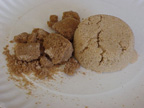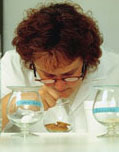Ingredient Function
Each ingredient in a product formula or recipe adds different functionality in the final product. This is the challenge in developing a new food product. The reactions between carbohydrates, proteins, water, fats, mechanical action, temperature, and other factors will affect the acceptability of the final product.
Carbohydrates
 These are the most abundant organic molecules on earth. They serve as a main source of energy from food. Each gram of carbohydrate produces 4 kilocalories of energy. Sugar and starches are the main sources of carbohydrate energy.
These are the most abundant organic molecules on earth. They serve as a main source of energy from food. Each gram of carbohydrate produces 4 kilocalories of energy. Sugar and starches are the main sources of carbohydrate energy.
Sugars can react with protein to cause non-enzymatic browning. This reaction is called the Maillard reaction. It can be a desirable or undesirable reaction.
Lipids
 Lipids (fats) are defined as water-insoluble organic substances found in animal and plant tissues. Lipids can provide body, mouth feel, plasticity, moistness, color and flavor. One problem with lipids is rancidity which will affect the flavor and odor of the product.
Lipids (fats) are defined as water-insoluble organic substances found in animal and plant tissues. Lipids can provide body, mouth feel, plasticity, moistness, color and flavor. One problem with lipids is rancidity which will affect the flavor and odor of the product.
Water
 This is a key ingredient in any food product. Water controls appearance, texture and flavor. It also affect whether or not microorganisms will grow. Water can be a solid, a liquid, or a gas. Water in frozen foods will affect the texture when the product is thawed. Types of water, such as soft or hard water, will affect the food product but also the effectiveness of sanitation.
This is a key ingredient in any food product. Water controls appearance, texture and flavor. It also affect whether or not microorganisms will grow. Water can be a solid, a liquid, or a gas. Water in frozen foods will affect the texture when the product is thawed. Types of water, such as soft or hard water, will affect the food product but also the effectiveness of sanitation.
Color
 The color of food affects our visual perception of the food and whether it will smell, taste, or feel good when eaten. Color can be natural and/or artificial. Color can also change during processing and storage.
The color of food affects our visual perception of the food and whether it will smell, taste, or feel good when eaten. Color can be natural and/or artificial. Color can also change during processing and storage.
Flavors
 Flavor has three components. They include taste, odor, and perception of pungency, heat and cooling. Flavors can be naturally occurring, generated from a cooking process, or the result of enzymatic reactions or microbial fermentation. Sometimes, flavor enhancers are needed to intensify or mask certain flavors. Other flavor additives include essential oils, flavor extracts, and flavor distillates.
Flavor has three components. They include taste, odor, and perception of pungency, heat and cooling. Flavors can be naturally occurring, generated from a cooking process, or the result of enzymatic reactions or microbial fermentation. Sometimes, flavor enhancers are needed to intensify or mask certain flavors. Other flavor additives include essential oils, flavor extracts, and flavor distillates.
Proteins
 Proteins provide structure and function. They can provide gel strength, generate foams, and help water-holding capacity. Proteins can bind water in a food system. They can also increase the viscosity of a product. Some proteins, such as meat myoglobin, provide color. Examples of some food proteins are egg albumin, wheat gluten, and meat collagen.
Proteins provide structure and function. They can provide gel strength, generate foams, and help water-holding capacity. Proteins can bind water in a food system. They can also increase the viscosity of a product. Some proteins, such as meat myoglobin, provide color. Examples of some food proteins are egg albumin, wheat gluten, and meat collagen.
